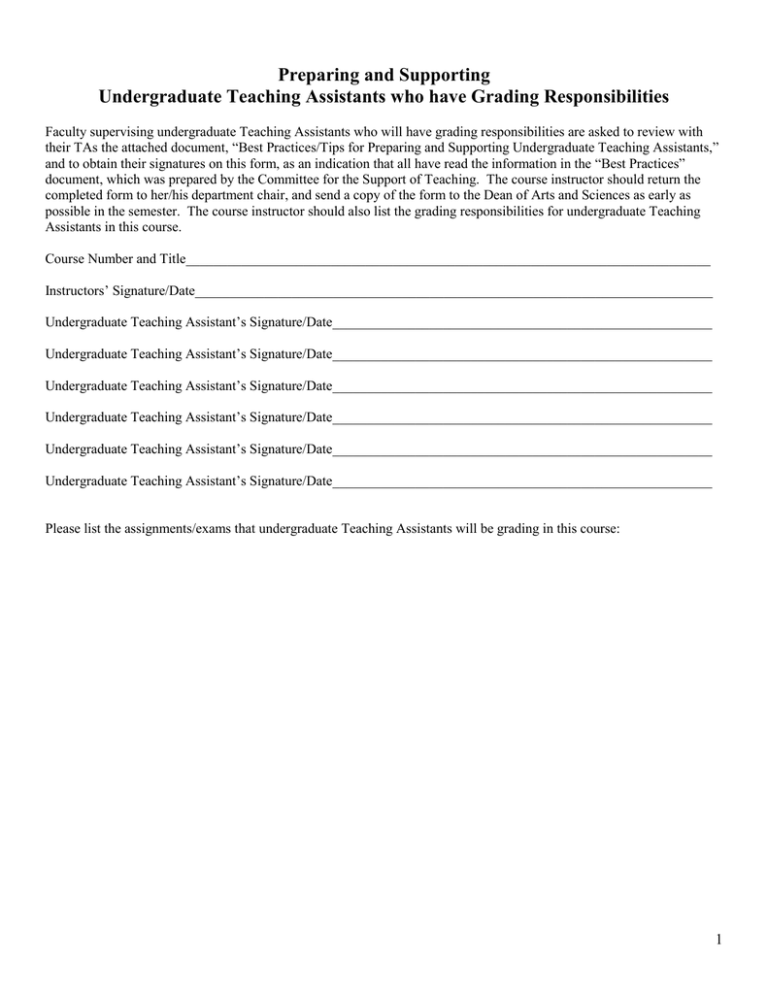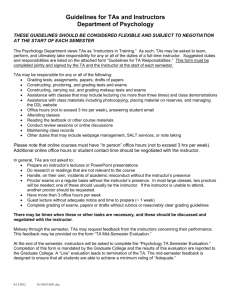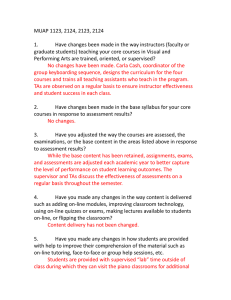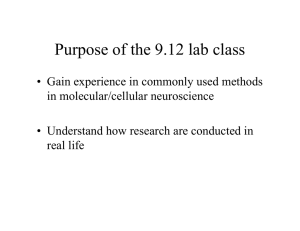Preparing and Supporting Undergraduate Teaching Assistants who have Grading Responsibilities
advertisement

Preparing and Supporting Undergraduate Teaching Assistants who have Grading Responsibilities Faculty supervising undergraduate Teaching Assistants who will have grading responsibilities are asked to review with their TAs the attached document, “Best Practices/Tips for Preparing and Supporting Undergraduate Teaching Assistants,” and to obtain their signatures on this form, as an indication that all have read the information in the “Best Practices” document, which was prepared by the Committee for the Support of Teaching. The course instructor should return the completed form to her/his department chair, and send a copy of the form to the Dean of Arts and Sciences as early as possible in the semester. The course instructor should also list the grading responsibilities for undergraduate Teaching Assistants in this course. Course Number and Title____________________________________________________________________________ Instructors’ Signature/Date___________________________________________________________________________ Undergraduate Teaching Assistant’s Signature/Date_______________________________________________________ Undergraduate Teaching Assistant’s Signature/Date_______________________________________________________ Undergraduate Teaching Assistant’s Signature/Date_______________________________________________________ Undergraduate Teaching Assistant’s Signature/Date_______________________________________________________ Undergraduate Teaching Assistant’s Signature/Date_______________________________________________________ Undergraduate Teaching Assistant’s Signature/Date_______________________________________________________ Please list the assignments/exams that undergraduate Teaching Assistants will be grading in this course: 1 Best Practices/Tips for Preparing and Supporting Undergraduate Teaching Assistants Before the Course Begins: TAs Selection Before making TA appointments, ask TA applicants what other jobs or activities they are undertaking, how many courses they are taking, etc., to get an idea of whether they really have enough time available to do a good job. Undergraduate TAs should not accept paid tutoring positions in the same course for which they are a TA. This potentially creates a conflict of interest. TA Training Prepare a handout/memo on Teaching Assistant Responsibilities for your course, including such topics as meetings with instructor, maintaining good communication, scheduling office hours, proctoring exams, etc. The instructor and TAs should have a discussion concerning the professional boundaries needed (e.g., importance of informing the instructor of a TA’s prior or existing relationship with a student enrolled in the class – see the Policy on Faculty/Staff Relations with Students, harassment policy, what topics are appropriate to discuss with students, etc.) when TAing a course. Undergraduate TAs could also participate in departmental training designed for graduate students. An Initial Meeting Course instructors typically meet with their TAs either individually or as a group at the start of the semester and periodically thereafter. The initial meeting could involve assigning course responsibilities, scheduling, setting course policies, etc. Discuss whether or not TA should attend class or schedule office hours. (Subsequent meetings could discuss how things are going and upcoming course events. Some instructors take notes and distribute summaries/minutes of at least the initial meeting.) At this first meeting, an instructor could also lead a general discussion about teaching, asking TAs, for example, what their own best and worst experiences have been in discussion sections or labs, what they hope to achieve in leading sections, etc. Spend time discussing the opening meeting of the section or lab, which usually sets a tone for the semester ahead. Talk about finding one’s own teaching style, being upfront about being nervous at the first meeting if one is, and the like. Emphasize how teaching material one has already studied is a great step forward in learning it more deeply and fully. Ask for initial input on what worked and didn’t work in this course/other similar courses in the past, and what would improve the course. During the Course: Office Hours/TA Sessions Ask TAs to keep a record of how busy they are during office hours, and review records with them for adjustments. Ask TAs to think about different ways to explain course concepts. Clarifying a concept for a student is often a matter of finding the right approach, e.g., theoretical, illustrative problems, hypothetical scenarios, etc. TAs should try to identify in advance those concepts that are likely to create the most difficulty and prepare accordingly (In some courses, TAs may be used to reading the prepared answers to problem sets rather than trying to answer the problems first, before reading the answers). TAs could be required to post comments on a TA website (in LATTE) each week addressed to students enrolled in the course. Topics might include common problems, information, and tips from instructor’s upcoming labs or classes. Discuss TA’s role in helping students with homework assignments. A common guideline is that TAs should confine their assistance to working through similar problems and going over the underlying concepts rather than providing answers to the homework problems. However, acceptable help may also include nudging a student toward the next step in the problem, again, without giving the final answer. 2 Communication Between Instructor and TAs Ask for feedback throughout the course to help you make adjustments to the course or plan future course revisions. TA staff and instructors should meet on a regular basis for about an hour, to talk about how sections are going, ideas for dealing with certain topics and texts, dealing with disappearing students, feedback from TAs and students about what is going well in the course and what is not, etc. TAs should email or otherwise talk with instructor each week about problems with specific students, dynamics in sections, and what they would change next time. TAs could also share what students found confusing, etc. TAs should feel free to let their instructors know if they are uncomfortable with an assigned task. Communication Between TAs and Students Discuss the importance of prompt responses to requests by the course instructor and other TAs and students. Tell TAs that if they do not have time to answer student questions in full or to meet with a student in a timely fashion, they should let the student know, and refer them to another TA or the instructor. TAs should also let the class know, preferably in advance, if they cannot make regular office hours. TAs should be encouraged to refrain from sending text messages or using personal cell phones to contact or communicate with students concerning the course. TAs should be encouraged to cc the instructor on all email with students concerning the class. Academic Honesty Discuss academic honesty policies and procedures. If TAs detect possible cheating, they should inform the course instructor so that he/she can take appropriate action. Other TA Responsibilities Give the undergrad TAs/peer assistants the opportunity to present some material in class. The students seem to appreciate the opportunity to hear material from another instructor, particularly when TAs are enthusiastic and able to explain the material in a language the students can relate to. It can also be a confidence-building experience for the peer assistants to lecture in front of a large class! For introductory courses, ask the undergrad TAs for tips on how to get the most out of the major. These tips on courses, getting involved in extracurricular activities, etc. can be shared with students on the final day of class. Proctoring Exams Undergraduates should only assist in proctoring exams when the course instructor is also present. Before the exam, the instructor should discuss the role of TAs in proctoring exams, and TAs should consult with the course instructor regarding how they should handle student questions. Should all questions be referred to the instructor? Can the TAs also answer student questions? If so, how far should they go in their answers? TAs need to know that it is not appropriate to chat during the exam, make phone calls, check email, read a book, etc. Grading Undergraduates who will be responsible for grading should be very carefully selected; they should be excellent students with a firm understanding of the material, mature and very conscientious. Some instructors select undergraduate graders only after they have “apprenticed” as TAs in several courses. In situations where undergraduates will have grading responsibilities, it is incumbent upon instructors to design assignments that can be reliably graded by TAs. Examples of assignments that could be graded by undergraduates include: 1. Problem sets that have minimal impact on the total grade, and for which grading standards are clearly specified. 2. Objective test questions that require minimal discretion on partial credit, e.g., multiple choice questions, true-false or short answers in which specific points are assigned for specific portions of the correct response. 3. Lab notebooks Undergraduates may not grade “essays.” Faculty should consider establishing and reviewing grading rubrics (grading highest and lowest examples) with undergraduate TAs prior to grading. “Grading parties” where the instructor and graders grade together as a group are a useful starting point for grading a particular assignment. 3 Faculty should be available to answer any TA questions throughout the grading process (review W. McKeachie’s Teaching Tips for additional suggestions). In some cases, there may be multiple ways to arrive at the right answer even though only one way is given in the instructor’s answer key. When in doubt, TAs should consult the course instructor. Grading discussions could also occur through posted comments on a LATTE TA website. TAs could suggest point allocations/deductions for different parts of a lab report, based on lab handouts and materials, and student performance/problems during the lab. The instructor could then use feedback from TAs to generate a grading scheme for each lab report and distribute this to increase consistency in TA grading. Ensure that TAs develop a system for keeping track of all student exams or assignments, and ask them to double check any homework scores recorded in LATTE. Require TAs to complete grading in a timely fashion, so that there are no delays in returning work to students. Ask TAs to distribute homework in such a way that students cannot see one another’s scores. A TA should inform the course instructor if s/he should be excused from grading any student’s work, because of prior or existing relationships (roommate, dating, etc.). It should be made clear to students that TAs have only minimal authority over students’ grades, and that appeals of TA decisions to the professor are OK- they will not cause the professor or the TA to be upset with the student. The ultimate responsibility for assigning grades always belongs to the professor of the course. With thanks to Milos Dolnik, Melissa Kosinksi-Collins, Gordon Fellman, Angela Gutchess, Rachel McCulloch, Jason Pontrello, and Scott Redenius. 4


